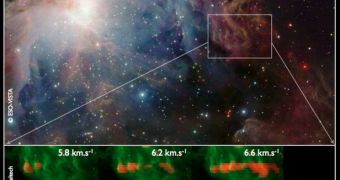As young massive stars form from large clouds of interstellar gas and dust, they are capable of producing massive ripples through the space structures, which stir up the gas, promoting even further stellar formation.
The conclusion belongs to a new scientific study, which showcases the example of a massive star that was born in a molecular cloud located inside the famous Orion Nebula.
Astronomers have in the study captured a view of the cosmic fireball as it was stirring up the ripples, which is very fortunate since the event has been rarely observed as it happens.
Details of the research, which was conducted by researchers at the Leiden University in the Netherlands, appear in the August 19 issue of the esteemed scientific journal Nature.
The team was led by expert Olivier Berne, who believes that the group may have identified traces of a type of stellar wind that may have affected the integrity of the cloud.
“We think it happened less than 1 million years ago, which is somewhat recent in astronomical scales,” the expert explains. He says that the stellar wind must have had an incredibly velocity.
The interactions that appear between stars and the molecular clouds that spawn them have made the object of countless astronomical studies thus far.
Experts known that winds and radiation emitted by the blue stars cause ripples, bow shocks and holes in the hydrogen gas, and have determined a long time ago that this is very helpful for the next generation of stars that will be formed.
If left unmixed, hydrogen gas clouds can take a lot longer to collapse into new stars than they do when they are mixed by stars and their explosions.
Another factor that contributes to intense stellar formation is the fact that massive stars live for short periods of time, of only a few million years. This means that a stellar nursery suffers the effects of intense stellar explosions very often.
The effects can be compared with some that exist on Earth as well, Space reports.
“In simple terms, it is the same type of ripples that you can see at the surface of the ocean when the wind is blowing over the water,” Berne explains.
“So what we think is happening is that the massive stars that are nearby, they blow winds of ionized gas, and this wind is running over the interstellar clouds and making these ripples in a similar way,” he adds.
“The ripples on the ocean occur when you have two fluids and a difference in velocity between these fluids,”, the expert argues.
“This produces the instability. You can see it on the ocean, and you can see it in the atmosphere at the surface of clouds. When clouds in the sky get ripples, it is because of this same mechanism of instability,” he concludes.

 14 DAY TRIAL //
14 DAY TRIAL //